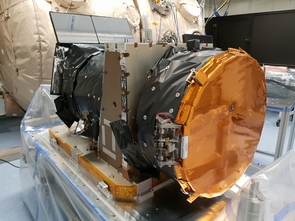Instrument
To achieve its scientific objectives CHEOPS will be able to detect Earth-size planets transiting G5 dwarf stars (stellar radius of 0.9 R☉) with V-band magnitudes in the range 6 ≤ V ≤ 9 mag. Since the depth of such transits is 100 parts-per-million (ppm), this requires a photometric precision of 20 ppm (goal: 10 ppm) in 6 hours of integration time, equivalent to the transit duration of a planet with a revolution period of 50 days.
 |
| The CHEOPS science instrument ready for shipment after completion of the calibration. Credit: University of Bern |
In the case of Neptune-size planets, CHEOPS will achieve a signal-to-noise ratio of 30 on such planets transiting K dwarf stars (stellar radius of 0.7 R☉) with V-band magnitudes in the range 9 ≤ V ≤ 12 (goal: 9 ≤ V ≤ 13). Since the depth of such transit is 2500 ppm, this requires a photometric precision of 85 ppm in 3 hours which is equivalent to the duration of a transit of a planet with a revolution period of 13 days.
The required photometric precision will be achieved using a single, frame-transfer, back-illuminated CCD detector from Teledyne e2v with 1024 × 1024 pixels and a pixel pitch of 13 µm. The CCD is mounted in the focal plane of a 32 cm diameter, f/8, on-axis Ritchey-Chrétien telescope, and will be passively cooled to 233 K, with a thermal stability of 10 mK.
Stray light, primarily from the Earth, will be a major source of noise and the telescope must be baffled to minimise its impact. Cleanliness and contamination requirements lead to the need for a cover which is light and dust tight. The detector plus support electronics together with the telescope, back-end optics, instrument computer and thermal regulation hardware are known collectively as the CHEOPS Instrument System (CIS).
The CIS is accommodated on the top panel of the platform and comprises a number of units:
- The Optical Telescope Assembly (OTA): this includes the telescope, the optical structure (mechanical support for OTA subsystems and the two star trackers), the back-end optics, the focal plane module (including the CCD, the focal plane array and front end electronics) and the radiators which provide cooling for the focal-plane array as well as the front end electronics.
- The Baffle and Cover Assembly (BCA): this includes the external baffle (axi-symmetric design) and the cover assembly, both mounted on the platform collar. The external baffle is designed to reject stray light from angles greater than 35 degrees from the line of sight. The cover assembly is made up of a cover lid, which is found at the entrance aperture of the external baffle and designed to minimise contamination of the CHEOPS optics up to and including launch, and a cover release mechanism to be used after launch.
- The Sensor Electronics Module (SEM): this comprises the sensor controller unit, used to control and read out the CCD, and the power conditioning unit used to condition/filter the voltages supplied to the CCD and to the CCD and front-end electronics thermal control.
- The Back-End Electronics (BEE): this comprises the digital processing unit and the power supply unit that provides the power for all elements of the CIS.





